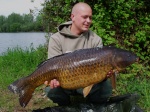| | bothriurus cf dumayi |  |
|
|
| Author | Message |
|---|
shanos
Babycurus

Number of posts : 295
Age : 41
Location : sheffield england
Registration date : 2011-03-09
 |  Subject: bothriurus cf dumayi Subject: bothriurus cf dumayi  2/15/2012, 12:09 pm 2/15/2012, 12:09 pm | |
| hi guys was wondering if any of u have a caresheet for this species or have any of u keept them thanks guy | |
|
  | |
**GS**
Leiurus

Number of posts : 2629
Age : 42
Location : facebook.com/ScorpionArchives
Registration date : 2010-09-06
 |  Subject: Re: bothriurus cf dumayi Subject: Re: bothriurus cf dumayi  2/15/2012, 7:24 pm 2/15/2012, 7:24 pm | |
| Hi Shanos,
I do not have have these beautiful specimens but i would just keep them like typical desert scorpions.
Anyhow.. i ran a search for you as well, not sure if you had came across these:
http://www.skorpione.de/forum/viewtopic.php?t=11346
http://www.reptilien-lexikon.de/index.php?id=212
Regards, | |
|
  | |
Callum B
Administrator

Number of posts : 1096
Age : 35
Registration date : 2008-09-21
 |  Subject: Re: bothriurus cf dumayi Subject: Re: bothriurus cf dumayi  2/15/2012, 8:28 pm 2/15/2012, 8:28 pm | |
| Oooo I've got some of these arriving tomorrow  They're another difficult to keep Chilean species by the sounds of things. I say difficult because no one knows anything about them. I'm sure as more info is obtained about them then the more people will have success. I have spent hours hunting info and papers about climate, habitat etc etc of these guys. They are from the Atacama Desert but they do not live in 100% arid conditions. I can't remember what the name was for them but they are found on hills that hold some humidity from the fogs that are common there. The German forum you linked GS has some good info. It's by far the best care sheet I have seen for them. I wish I'd found it earlier lol. | |
|
  | |
Callum B
Administrator

Number of posts : 1096
Age : 35
Registration date : 2008-09-21
 |  Subject: Re: bothriurus cf dumayi Subject: Re: bothriurus cf dumayi  2/16/2012, 5:59 am 2/16/2012, 5:59 am | |
| Here are the obligatory pictures of my new arrivals. They are stunning. Really nice markings and colouration. This is the larger of the two, and measures approx. 6cm.   And the smaller, at around 4cm.   Fingers crossed that I'll do something right and they survive for a decent amount of time. Shanos, are you going to get any?? | |
|
  | |
shanos
Babycurus

Number of posts : 295
Age : 41
Location : sheffield england
Registration date : 2011-03-09
 |  Subject: Re: bothriurus cf dumayi Subject: Re: bothriurus cf dumayi  2/16/2012, 7:41 am 2/16/2012, 7:41 am | |
| yeah i think these are the next ones on my hit list there really awesome looking man dude | |
|
  | |
shanos
Babycurus

Number of posts : 295
Age : 41
Location : sheffield england
Registration date : 2011-03-09
 |  Subject: Re: bothriurus cf dumayi Subject: Re: bothriurus cf dumayi  2/16/2012, 7:42 am 2/16/2012, 7:42 am | |
| thanks gs for the info no one seems to have had any experince with them lol | |
|
  | |
shanos
Babycurus

Number of posts : 295
Age : 41
Location : sheffield england
Registration date : 2011-03-09
 |  Subject: Re: bothriurus cf dumayi Subject: Re: bothriurus cf dumayi  2/16/2012, 8:03 am 2/16/2012, 8:03 am | |
| so sand and ex clay mix for substrate then llol | |
|
  | |
**GS**
Leiurus

Number of posts : 2629
Age : 42
Location : facebook.com/ScorpionArchives
Registration date : 2010-09-06
 |  Subject: Re: bothriurus cf dumayi Subject: Re: bothriurus cf dumayi  2/16/2012, 8:29 am 2/16/2012, 8:29 am | |
| Maybe they like it just like Scorpio maurus palmatus? and Callum, Very nice pictures you have posted. Those daylight shots are so refreshing and clear, especially pic #1. & that exotic scorpion with camo on it's face... gorgeous! Are they wild-caught or captive breed by your dealer? Do document them well if you can, be the first to write a detailed ASA on them  Wish you lucking in breeding them! | |
|
  | |
Callum B
Administrator

Number of posts : 1096
Age : 35
Registration date : 2008-09-21
 |  Subject: Re: bothriurus cf dumayi Subject: Re: bothriurus cf dumayi  2/16/2012, 8:39 am 2/16/2012, 8:39 am | |
| - shanos wrote:
- yeah i think these are the next ones on my hit list there really awesome looking man dude
Sweet  Sand and excavator plus abit of coconut fibre to hold some moisture is what I am trying. I just don't know GS. I think S. maurus have a wet (relatively speaking) and dry season, whereas where these guys are from it never rains but they do have moisture from fog that is captured by coastal hills at a certain height. B. dumayi have a wide range but are only found in the places where this hill fog collects. Kind of on hill islands in the middle of a desert sea lol. Exactly how moist these hills are though, I don't know as there is bugger all info. on them, plus I can't remember the proper term for them lol. I guess it's going to be trial and error on how moist to keep them. Hopefully with no error lol. Oh and cheers for the compliments GS  | |
|
  | |
**GS**
Leiurus

Number of posts : 2629
Age : 42
Location : facebook.com/ScorpionArchives
Registration date : 2010-09-06
 |  Subject: Re: bothriurus cf dumayi Subject: Re: bothriurus cf dumayi  2/16/2012, 9:12 am 2/16/2012, 9:12 am | |
| Good thinking, always try to replicate their natural environment since you know the detailed location they are from. Safest bet might still be keeping them on the drier side but with a small capful of water in a corner which you'll fill once every 1-2 weeks, occasionally allow the water to overflow a little.. Along with unrestricted ventilation and your natural looking setup.. shouldn't be a prob i would say.. shouldn't be a prob at all  | |
|
  | |
DolbyR
Leiurus

Number of posts : 2097
Age : 42
Location : facebook.com/ScorpionArchives
Registration date : 2011-01-03
 |  Subject: Re: bothriurus cf dumayi Subject: Re: bothriurus cf dumayi  2/16/2012, 10:10 am 2/16/2012, 10:10 am | |
| +1
If they're from the Atacama desert, I would just keep them as a Chile rose. Bone dry substrate, cup of water and good ventilation, like GS suggested. | |
|
  | |
Callum B
Administrator

Number of posts : 1096
Age : 35
Registration date : 2008-09-21
 |  Subject: Re: bothriurus cf dumayi Subject: Re: bothriurus cf dumayi  2/16/2012, 10:50 am 2/16/2012, 10:50 am | |
| It's a difficult one lol. I have read a few reports of them being kept quite humid and the scorpions died pretty quickly but the German caresheet GS posted states they need some moisture and the tiny bit of info in this paper states ''Most localities of B. dumayi have been reported as belonging to the plant formation known as ‘‘lomas’’. These are patches of vegetal communities situated from 0 to 1100m, which receive more humidity than the surrounding desert thanks to the interception of fog (‘‘camanchacas’’) originated in the ocean
(Rundel et al., 1991).'' http://research.amnh.org/users/lorenzo/PDF/Mattoni.2006.SNeo.Bothriurus.pdf
Lomas!! That's the name of those hills lol!!!
I just want to know how much humidity these hills receive but google is failing me. Would there be moisture trapped under rocks, just under the soil etc. or does it only form as dew on the surface when the fog rolls in? I'm getting frustrated now lol.
Thankyou for your input though guys. For now I think I will try a small bottle cap and a very light misting once or twice a week. Mid to high 20c's during the day and no heat at night. What do you reckon? | |
|
  | |
shanos
Babycurus

Number of posts : 295
Age : 41
Location : sheffield england
Registration date : 2011-03-09
 |  Subject: Re: bothriurus cf dumayi Subject: Re: bothriurus cf dumayi  2/17/2012, 8:07 am 2/17/2012, 8:07 am | |
| its a hard one mate init id prod do as that german guy did put a small bottle cap of water in every three to four days and mist couple times a week if u think about it theregonna get moist if they live around the vegitation cos there will be a dew every morning as for temp its says high 20cs to 30cs and room temps at night but as u say callum its gonna be trial and error | |
|
  | |
Jay
SCORPIONMOD

Number of posts : 1250
Age : 36
Location : England
Registration date : 2010-05-05
 |  Subject: Re: bothriurus cf dumayi Subject: Re: bothriurus cf dumayi  2/20/2012, 6:22 am 2/20/2012, 6:22 am | |
| Sweet new additions Callum, I've been eyeing these up for a while  Love their markings. I've been put off by the same thing though, none of my Chile scorps seem to survive very long, I wish you luck! | |
|
  | |
Bufo Bill
Pandinus
Number of posts : 6
Age : 44
Location : Wolverhampton, UK
Registration date : 2011-09-06
 |  Subject: Re: bothriurus cf dumayi Subject: Re: bothriurus cf dumayi  2/20/2012, 5:29 pm 2/20/2012, 5:29 pm | |
| I had a similar scorpion known as Bothriurus "Large Claw", which I had for three years. the tank was sand and coir bedding ontop of a drainage layer of gravel. The substrate was allowed to dry periodically before one section was wetted with about 10 ml water. I don't really think this is the best way of doing things, because my specimen would eat only very rarely. Just thought I'd put the info on the record. All the best from Bill.  Edit: Temp was 25-30 C summer (cooler at night) and 20-25 C winter (again, cooler night temp) | |
|
  | |
Callum B
Administrator

Number of posts : 1096
Age : 35
Registration date : 2008-09-21
 |  Subject: Re: bothriurus cf dumayi Subject: Re: bothriurus cf dumayi  2/20/2012, 6:19 pm 2/20/2012, 6:19 pm | |
| Cheers man.
3 years is very good going compared to most. It seems a small amount of moisture may be beneficial. | |
|
  | |
DolbyR
Leiurus

Number of posts : 2097
Age : 42
Location : facebook.com/ScorpionArchives
Registration date : 2011-01-03
 |  Subject: Re: bothriurus cf dumayi Subject: Re: bothriurus cf dumayi  2/21/2012, 4:18 am 2/21/2012, 4:18 am | |
| I think Chilean arachnids usually eat periodically due to the changes of climate/food availability in the region. It is up to us to try and replicate these changes to give them an idea when it is the "right" season for eating. | |
|
  | |
Annababe
Tityus

Number of posts : 834
Age : 53
Location : Tucson, AZ
Registration date : 2011-06-30
 |  Subject: Re: bothriurus cf dumayi Subject: Re: bothriurus cf dumayi  2/21/2012, 4:15 pm 2/21/2012, 4:15 pm | |
| Beautiful scorpions  | |
|
  | |
**GS**
Leiurus

Number of posts : 2629
Age : 42
Location : facebook.com/ScorpionArchives
Registration date : 2010-09-06
 |  Subject: Re: bothriurus cf dumayi Subject: Re: bothriurus cf dumayi  2/21/2012, 9:50 pm 2/21/2012, 9:50 pm | |
| - DolbyR wrote:
- I think Chilean arachnids usually eat periodically due to the changes of climate/food availability in the region. It is up to us to try and replicate these changes to give them an idea when it is the "right" season for eating.
+1 Thats right. Captive breeding is all about providing the most naturalistic environment (whenever possible) from the critter's origin. Again, these are truly gorgeous specimens to own seriously  | |
|
  | |
DolbyR
Leiurus

Number of posts : 2097
Age : 42
Location : facebook.com/ScorpionArchives
Registration date : 2011-01-03
 |  Subject: Re: bothriurus cf dumayi Subject: Re: bothriurus cf dumayi  2/22/2012, 5:52 am 2/22/2012, 5:52 am | |
| - GS wrote:
- Captive breeding is all about providing the most naturalistic environment (whenever possible) from the critter's origin.
Exactly! That's the biggest challenge too, specially with species originating from location below the equatorial line. The seasons are reversed and the scorpions often lose a sense of the real season of the year, leading to feeding problems. - Quote from Stan Shultz's book:
The following text regards C. rosea feeding/husbandry problems but I strongly believe it will apply to any scorpion native to the same region/environment/climate
In the Atacama they experience seasonal fluctuations
in temperature, water/humidity availability, day length, and food
availability. They use one, some or all of these to entrain their annual
cycles, to synchronize their lives with the rest of Mother Nature. Their
species evolved in this absolutely predictable waltz of variations. Each
individual tarantula has grown up in these conditions.
Then somebody snatches them out their lair and ships them to the other
side of the planet. Worse yet, we keep them in a house with
thermostatically controlled heat. There goes any temperature clues to let
them readjust to the new time table.
We get up and turn the lights on every morning at 6:30 or 7:00 AM and the
house is well lit until we turn the lights off at 10:30 or 11:00 PM. And
this never changes regardless of what season of the year it is. We've just
removed day length as a clue.
Worse yet, in nature they're preprogrammed to eat as much food as
available in preparation for the coming famine season. (There's *ALWAYS* a
coming famine season!) During the famine season they may go hungry for
several months before food becomes plentiful again, another seasonal clue.
In captivity we give them all the food they'll eat and, out of instinct,
they eat everything that we throw at them. We overfeed them thinking that
they're starved and they don't stop eating until they're obese. Even then
the food *STILL* keeps coming! There is no string of light meals followed
by a few months of fasting. This destroys any food availability clues
completely.
Lastly, in the Atacama, as dry as it is, there are dry seasons and damp
seasons. It may not rain often, but from time to time fog banks roll in
from the Pacific and generally moisten everything for a few hours to
several days. And, this tends to happen seasonally. In your home its
always bone dry, but you always keep a dish of water in the cage. Ooops!
There goes another clue.
The result is that this species more than almost any other gets really
confused about what season of the year it is. Because we've removed all
their clues they don't know when to start eating again once they get too
fat and stop. Neither do they know when it should be time to molt. They
may go 2 years or more without eating or molting, before they finally pick
up the few very subtle clues available to synchronize with the local
seasons.
- GS wrote:
- Again, these are truly gorgeous specimens to own seriously
+1 
Last edited by DolbyR on 2/22/2012, 1:38 pm; edited 1 time in total | |
|
  | |
Callum B
Administrator

Number of posts : 1096
Age : 35
Registration date : 2008-09-21
 |  Subject: Re: bothriurus cf dumayi Subject: Re: bothriurus cf dumayi  2/22/2012, 1:13 pm 2/22/2012, 1:13 pm | |
| Cheers for that extract Dolby  . Does the author go on to describe the climate of the Atacama any further?? | |
|
  | |
Bufo Bill
Pandinus
Number of posts : 6
Age : 44
Location : Wolverhampton, UK
Registration date : 2011-09-06
 |  Subject: Re: bothriurus cf dumayi Subject: Re: bothriurus cf dumayi  2/22/2012, 2:11 pm 2/22/2012, 2:11 pm | |
| To clarify my previous post: these are the same species as the Bothriurus sp. "Large Claw", which I gave my culturing info for. All the best from Bill.  | |
|
  | |
DolbyR
Leiurus

Number of posts : 2097
Age : 42
Location : facebook.com/ScorpionArchives
Registration date : 2011-01-03
 |  Subject: Re: bothriurus cf dumayi Subject: Re: bothriurus cf dumayi  2/23/2012, 3:45 am 2/23/2012, 3:45 am | |
| - Callum B wrote:
- Cheers for that extract Dolby
 . Does the author go on to describe the climate of the Atacama any further?? . Does the author go on to describe the climate of the Atacama any further?? - Further text on Atacama climate:
The Atacama can be one of the
harshest environments on the planet! There are parts of it that have never
had rain in recorded history. The temperatures there may reach 135 F (57
C) or higher in Summer. They may experience light frosts in Winter.
I don't know if there is something more in the book (Tarantula keeper's guide) as I don't own it. This might be a help too if you haven't seen it yet. | |
|
  | |
Sponsored content
 |  Subject: Re: bothriurus cf dumayi Subject: Re: bothriurus cf dumayi  | |
| |
|
  | |
| | bothriurus cf dumayi |  |
|

